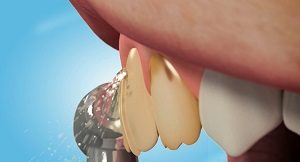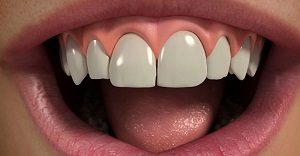A veneer is a thin tooth-coloured shell fixed to the front of a tooth to mask discolouration, an irregular shape, damage or small gaps. They are usually fitted to the front upper and lower teeth and are made from ceramic, porcelain or a composite material. They can be used to enhance your smile and help to protect an affected tooth from further damage.
Veneers offer a minimally invasive way to transform a tooth as only a very thin layer of enamel is removed (if any) prior to fitting.
Benefits
- More of the healthy tooth can be retained
- Natural-looking
- Durable
- Colour matched to your natural teeth
- Can correct a number of flaws
- Stain resistant
Treatment steps
- If necessary, a thin layer of enamel is removed from the surface of the tooth to accommodate the veneer.
- Once prepared, impressions are taken so a customised veneer can be produced in a laboratory. The colour of your teeth is also noted so it will blend in perfectly.
- When ready, the veneer is bonded to the tooth using a strong dental adhesive.
Aftercare
After fitting, it is important to keep your veneer well-maintained with regular brushing and flossing. Your dentist and hygienist will show you how to keep on top of your dental hygiene and keep a close eye on the health of your teeth and gums.
Although veneers are resilient, it is important to treat them with care, so try not to bite your fingernails or chew pen tops, or use your teeth to open anything. Also, it is probably best to steer clear of very hard foods that could cause damage to the veneer.
What is a veneer?
 A veneer is a thin layer of porcelain made to fit over the front surface of a tooth, like a false fingernail fits over a nail. Sometimes a natural colour ‘composite’ material is used instead of porcelain.
A veneer is a thin layer of porcelain made to fit over the front surface of a tooth, like a false fingernail fits over a nail. Sometimes a natural colour ‘composite’ material is used instead of porcelain.
What are the advantages of veneers?
Veneers make teeth look natural and healthy, and because they are very thin and are held in place by a special strong bond (rather like super-glue) very little preparation of the tooth is needed.
When would I need a veneer?
Veneers can improve the colour, shape and position of teeth. A precise shade of porcelai n can be chosen to give the right colour to improve a single discoloured or stained tooth or to lighten front teeth (usually the upper ones) generally. A veneer can make a chipped tooth look intact again. The porcelain covers the whole of the front of the tooth with a thicker section replacing the broken part. Veneers can also be used to close small gaps, when orthodontics (braces) are not suitable. If one tooth is slightly out of position, a veneer can sometimes be fitted to bring it into line with the others.
n can be chosen to give the right colour to improve a single discoloured or stained tooth or to lighten front teeth (usually the upper ones) generally. A veneer can make a chipped tooth look intact again. The porcelain covers the whole of the front of the tooth with a thicker section replacing the broken part. Veneers can also be used to close small gaps, when orthodontics (braces) are not suitable. If one tooth is slightly out of position, a veneer can sometimes be fitted to bring it into line with the others.
What about alternatives?
A natural-coloured filling material can be used for minor repairs to front teeth. This is excellent where the tooth supports the filling, but may not work so well for broken tooth corners. There will always be a join between the tooth and the filling material.
Crowns are used for teeth that need to be strengthened – either because they have broken, have been weakened by a very large filling, or have had root canal treatment.
How long will a veneer last?
Veneers should last for many years, but they can chip or break, just as your own teeth can. Your dentist will tell you how long each individual veneer should last. Small chips can be repaired, or a new veneer fitted if necessary.
How are teeth prepared for a veneer?
Some of the shiny outer enamel surface of the tooth may be removed, to make sure that the veneer can be bond ed permanently in place later. The amount of enamel removed is tiny and will be the same as the thickness of the veneer to be fitted, so that the tooth stays the same size. A local anaesthetic (injection) may be used to make sure that there is no discomfort, but often this is not necessary. Once the tooth has been prepared, the dentist will take an ‘impression’. This will be given to the dental technician, along with any other information needed to make the veneer. The colour of the surrounding teeth is matched on a shade guide to make sure that the veneer will look entirely natural.
ed permanently in place later. The amount of enamel removed is tiny and will be the same as the thickness of the veneer to be fitted, so that the tooth stays the same size. A local anaesthetic (injection) may be used to make sure that there is no discomfort, but often this is not necessary. Once the tooth has been prepared, the dentist will take an ‘impression’. This will be given to the dental technician, along with any other information needed to make the veneer. The colour of the surrounding teeth is matched on a shade guide to make sure that the veneer will look entirely natural.
How long will it take?
A veneer takes at least two visits; the first to prepare the tooth and to match the shade, and the second to fit it. Before bonding it in place, your dentist will show you the veneer on your tooth to make sure you are happy with it. Bonding a veneer in place is done with a special adhesive, which holds it firmly on the tooth.
Will I need a temporary veneer between visits?
Because the preparation of the tooth is so slight you will probably not need a temporary veneer. The tooth will look very much the same after preparation, but will feel slightly less smooth.
What happens after the veneer is fitted?
Only minor adjustments can be made to the veneer after it is fitted. It is usually best to w ait a little while to get used to it before any changes are made. Your dentist will probably want to check and polish it a week or so after it is fitted, and to make sure that you are happy with it.
ait a little while to get used to it before any changes are made. Your dentist will probably want to check and polish it a week or so after it is fitted, and to make sure that you are happy with it.
